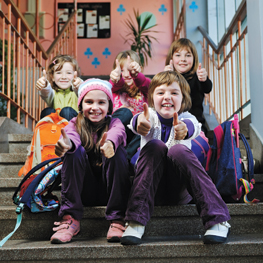
When Shawna Crist’s daughter Carly entered third grade last September, the eight-year-old fully expected to continue hanging out with a girl she considered a close friend. “But pretty soon, I wasn’t hearing this little girl’s name anymore,” recalls Crist. When pressed, Carly offered, “Mom, she’s just not the same. All she talks about is softball.” And while Carly enjoys that sport, she just doesn’t play it at the same level or with the same degree of interest as her now former pal does.
It’s tough to navigate the ever-shifting social scene of elementary school. The upper grades in particular can be a breakaway time for a lot of kids. Polarization around different activities becomes evident, cliques form and long relied upon friends start to move in different circles. How can you help your child deal with a tricky new set of social dynamics?
In the early school years, it’s very typical for kids to develop friendships based on proximity. “But as kids grow up, it’s less about being in the same classroom or even on the same team and more about mutual interests and how those interests relate to who they are as individual people,” says Cathi Cohen, a licensed clinical social worker, certified group psychotherapist and author of Raise Your Child’s Social IQ: Stepping Stones to People Skills for Kids. ”Their identities are shifting at this age and they’re really trying to figure out who they are.” Unfortunately, feelings often get hurt during the process.
The good news is you can equip your child with tools to navigate some of the more common social challenges:
Waning friendships – Girls in particular feel the pain when others create distance. Cohen encourages parents to help their child focus on developing new relationships based on their evolving interests. Perhaps a playdate can be arranged or a shared extracurricular activity. “Get them to focus less on what they’ve lost and more on what they stand to gain through their own areas of interest,” she says. It doesn’t have to be a horde of new pals, just one or two solid friendships. This would also be a good time to underline what friendship really means. A lot of kids are adept at the initial stages but not so good on maintenance. School them on follow-up skills like calling and checking in, bringing homework assignments to a sick friend, etc.
Too cool for school – Subtle slights can escalate into something more serious especially when your child butts up against a dreaded clique. When your child comes home upset or in tears because she got the brush-off at a lunch table or he was the last one picked for a kickball game, the first thing you need to do is empathize, says Michele Borba, Ed.D., author of Nobody Likes Me, Everybody Hates Me: The Top 25 Friendship Problems and How to Solve Them.
Next, be careful what you model because girls in particular look to their moms for clues on how to deal with the ins and outs of relationships.
The third thing is to nurture: “Give your child a strong sense of self-esteem from the inside out. Find healthy ways for your child to just feel good about who they are because when the going gets rough, they absolutely will rely and be more resilient if they have some kind of a hobby or interest,” she says.
Should teasing and putdowns occur, help your child develop comeback strategies. Borba outlines some effective ones at www.micheleborba.com/Pages/ArtNLM08.htm. The absolute worst thing is to insult a bully and the best thing is to appear unfazed. “It’s not so much what a child says but how they say it that makes a difference,” she says. Clue your child into the fact that what bullies crave most is power and control over others. Then help your son or daughter practice some responses to make sure they never get it.
Tiffs and tough times – As they forge new interests and friendships, eight to 10 year olds are bound to experience some bad days, even in the absence of extreme bullying. Friends who run hot and cold, activities they’re included in and later not, welcoming smiles replaced by sideways glances seemingly overnight. Whether they voice it or not, children look to their elders for guidance - you’re a steady point in unstable seas.
Towards that end, Cohen suggests an exercise she’s labeled “EG NOG” for parents to use next time their child comes home upset.
The acronym breaks down as follows:
E: is for Empathize.
G: is for Get neutral and listen as they spill out their story. At some point, they’ll speak out and that’s when you can begin to...
N: Narrow their focus. Ask which part of this upset them the most? Which part can you help them fix? After you help them narrow it down into a more realistic thinking pattern, then you can...
O: Operationalize. Meaning put into action a plan for dealing with that one piece he or she can do something about. And then…
G: Get moving. Have your child get moving on the plan, hopefully develop a backup plan and then have them report back after they try it out. If it didn’t work, how can it be tweaked to make sure it does?
“The EG NOG process is a way of empowering kids. It’s a way of keeping you neutral as a parent while helping them cognitively limit their distortions. It keeps them focused on the part of the situation they do have control over and that they can change,” says Cohen. Add it to your arsenal of coping strategies and together you and your child can ride out any storm!
Freelance writer June writes frequently on parenting and education-related topics.
Calgary’s Child Magazine © 2025 Calgary’s Child